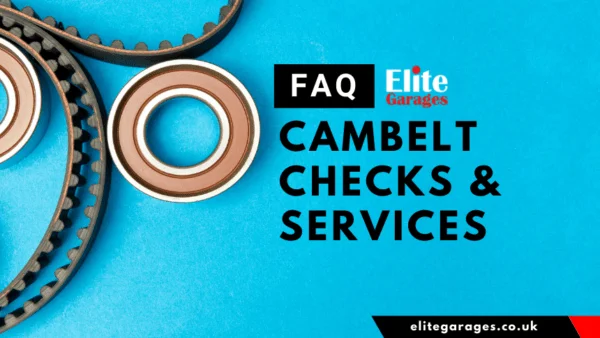
Questions And Answers About Cambelt Replacement
Your cambelt (also known as a timing belt) is among the most important maintenance items in your vehicle. Replacing your cambelt is essential as it doesn’t last forever and failing to do so according to the manufacturer’s recommendations can end up in very costly engine repairs. To help ensure your car stays in tip-top condition, here are some of the most common questions with detailed answers.
 What Is A Cambelt?
What Is A Cambelt?
A cambelt is often ribbed and placed inside the car’s engine to keep the camshaft and crank timed correctly. It’s designed to keep the bottom half of the engine (pistons and crankcase) in sync with the top half which includes the valves and cylinder head. To ensure proper timing, the cambelt is placed in a very particular arrangement.
Does My Car Have A Timing Belt Or Timing Chain?
Whilst cambelts are placed outside the engine, timing chains are typically housed inside lubricated by the engine oil. Although some manufacturers have switched to metal timing chains, most cars still have ribbed rubber belts. It all depends on the make and model as most BMW and Mercedes cars use cam chain engines, for example. If you’re unsure, check your vehicle handbook or call your nearest Elite Garage for assistance.
What Does A Cambelt Do?
In internal combustion engines, the timing belt or cambelt connects the crankshaft to the camshaft(s). This synchronisation allows the engine valves to open and close at the proper intervals during each cylinder’s intake and exhaust strokes. In an interference engine, the cambelt also plays a crucial role in preventing pistons from striking the valves which can result in serious (and expensive) damage.
Why And When Does A Cambelt Need Replacing?
Like most parts of a car, cambelts will eventually wear out but with some serious consequences. Over time, cambelts can stretch and that will only accelerate wear which could cause the belt to fail without warning. If you don’t replace the cambelt before it cracks, tears or snaps, you could be left with some expensive repairs.
There’s no set mileage or timeframe in terms of a cambelt replacement as it varies between car make and model along with how you drive. Many manufacturers recommend a replacement anywhere from 40,000 to 100,000 miles or 4+ years. You will usually have to replace the belt more than once during the vehicle’s lifetime. Check your vehicle handbook to see what your manufacturer recommends.
If you are concerned about your cambelt or unsure whether it needs replacing, visit or phone your nearest Elite branch.
How Much Does A Cambelt Replacement Cost?
The cost of fitting a new timing belt and labour varies depending on the vehicle make and model. Prices for parts and labour can be anywhere from £250 to more than £500, or even over £1,000 for some luxury vehicles. It’s best to call for a quote as you will be able to speak to someone who can provide you with the necessary information.
How Long Does The Service Take?
Considering the amount of effort it takes to replace a timing belt, it could take a few hours. Replacing it involves taking apart the engine block and putting it back together again.
Should I Replace The Water Pump At The Same Time As The Timing belt?
In some cars, technicians have to remove the cambelt to get to the water pump. That doesn’t mean you have to do it but replacing your water pump at this stage may be worth your while. If you don’t replace the water pump during a cambelt change, you run the risk of having to pay the same labour again if the water pump goes at a later stage.
What Happens If My Cambelt Breaks?
If you haven’t realised it yet, you cannot drive a car if the cambelt is broken. As it gets older and worn out, there’s always a risk that the precision timing can fail. If that happens, your valves won’t open at the right time, the air and fuel mixture may not ignite at the right time and you could suffer misfires, loss of performance, and other serious issues.
The most common result of a snapped cambelt while driving is that the valves will bend. There’s also a high likelihood of damage to the cylinder head and camshaft, including the cylinder walls and pistons. Failure to replace the belt can result in a complete breakdown or catastrophic engine failure, especially in interference engines.
Related: ‘Interference Vs Non-Interference Engines: Animation’
Vehicle Servicing And Cambelts At Elite Garage
To avoid disastrous engine failure and excessive repair bills, we highly recommend having your cambelt check at least once a year. Regardless of what a cambelt change may cost, it’s important to check and replace if needed as prevention is better than cure, especially with this car part.
If you notice a ticking noise from the engine, trouble starting the car, engine misfires or oil leaking from the front of the engine, it may be time to check your cambelt. Whilst a cambelt change is not part of a regular service, Elite’s technicians will inspect its condition and report back if work is needed.
And remember, we don’t perform any additional work without your strict approval. You can find a list of all our branches on the website where you can also book a service, MOT, reserve tyres or arrange a free vehicle safety check.
About Us
Opening Times
Saturday : 8:30–4:00
Sunday : closed
More Information
Contact UsCustomer Information Pack
Check MOT Due Date
Free MOT reminder
Careers
Legal Information
Recent Posts
- Want to Prevent Exhaust Damage and Reduce Emissions?
- Regular Car Maintenance: Joe Achilles Tests Elite Garages’ 250,000-Mile BMW
- Clutch Replacement Near Me: A Comprehensive Guide for UK Drivers
- Antifreeze Coolant: What It Is, How It Works, and When to Use It
- MOT in Brighton: Your Essential Guide to Testing, Servicing and Tyre Safety


